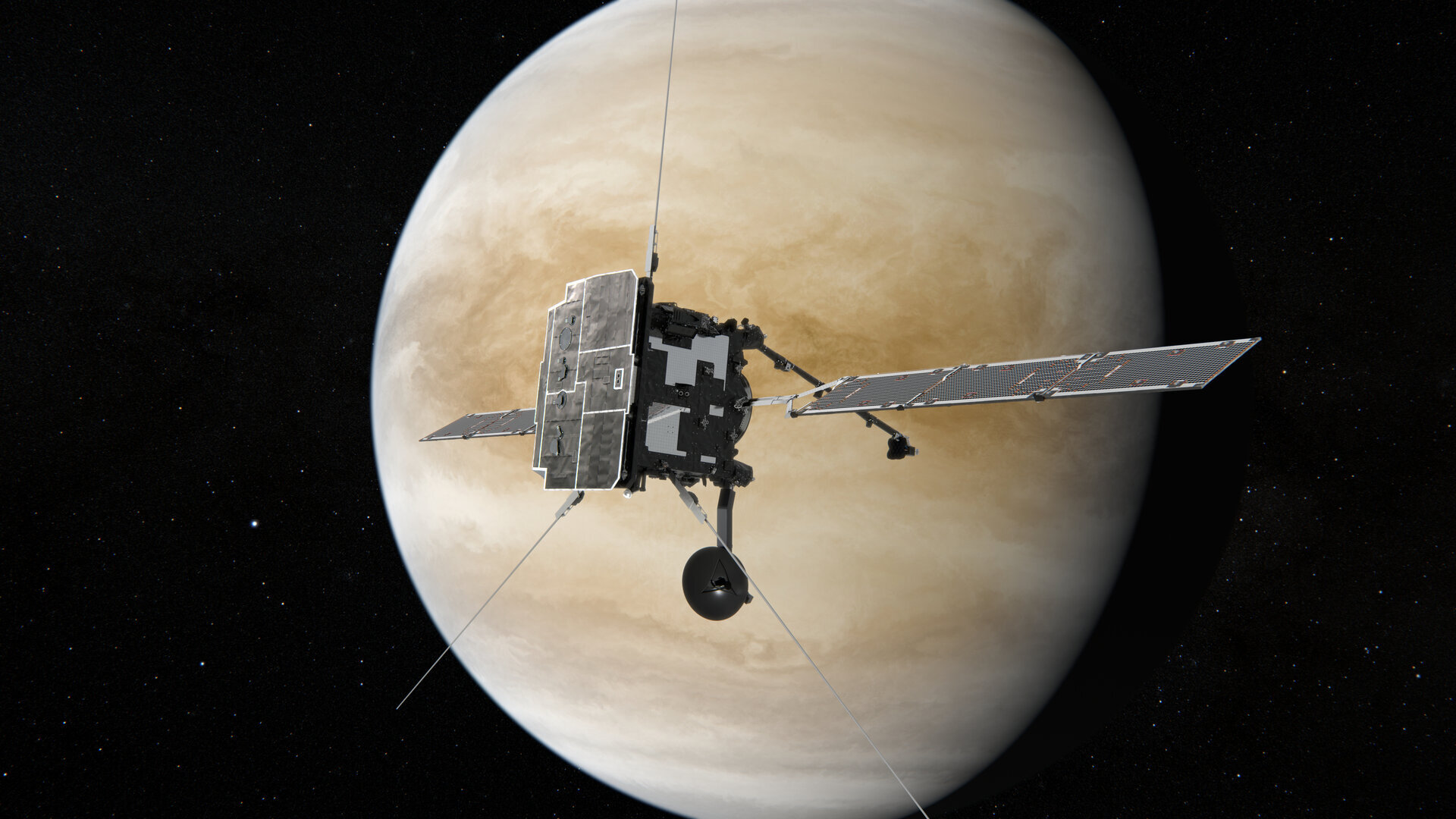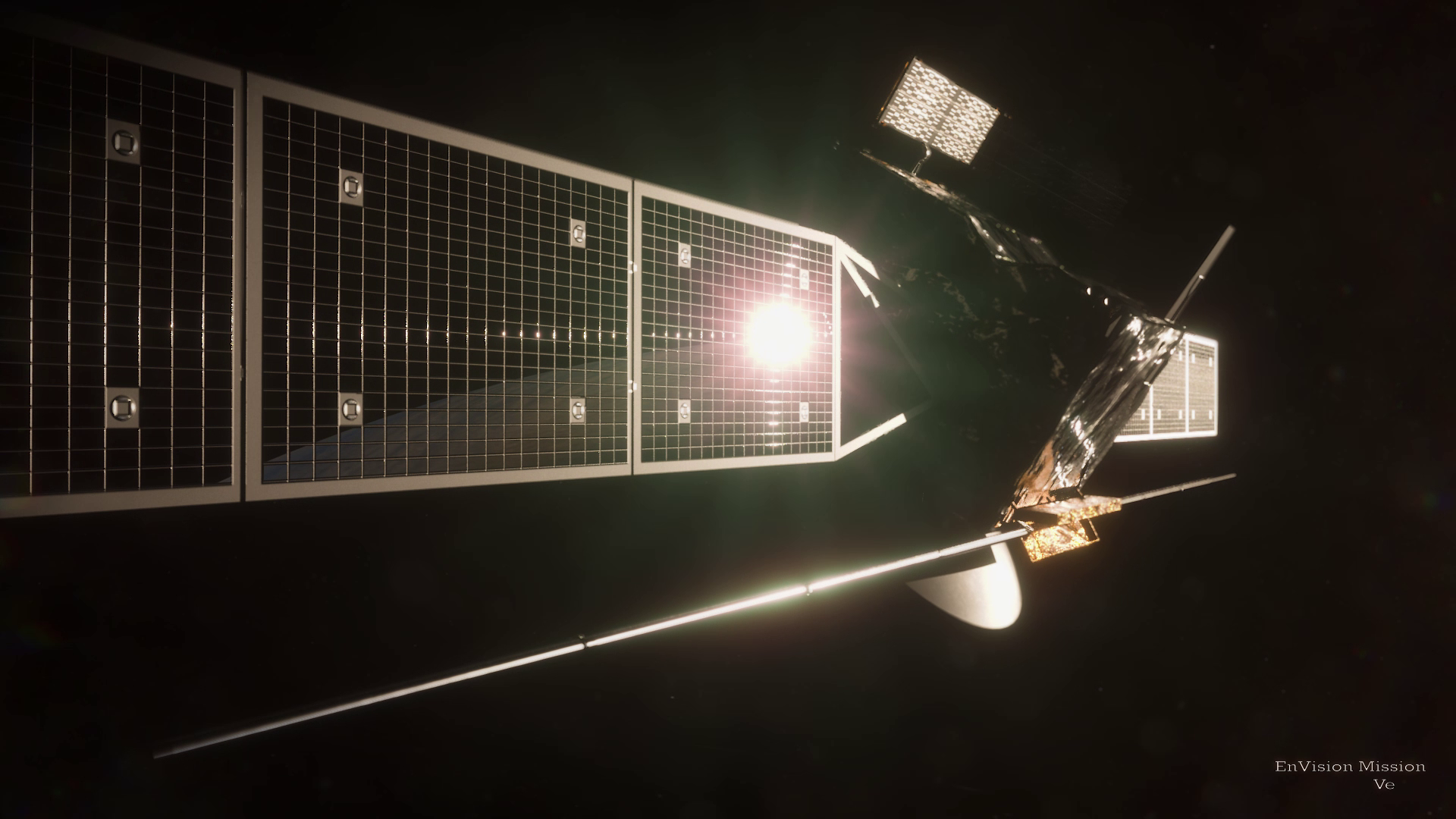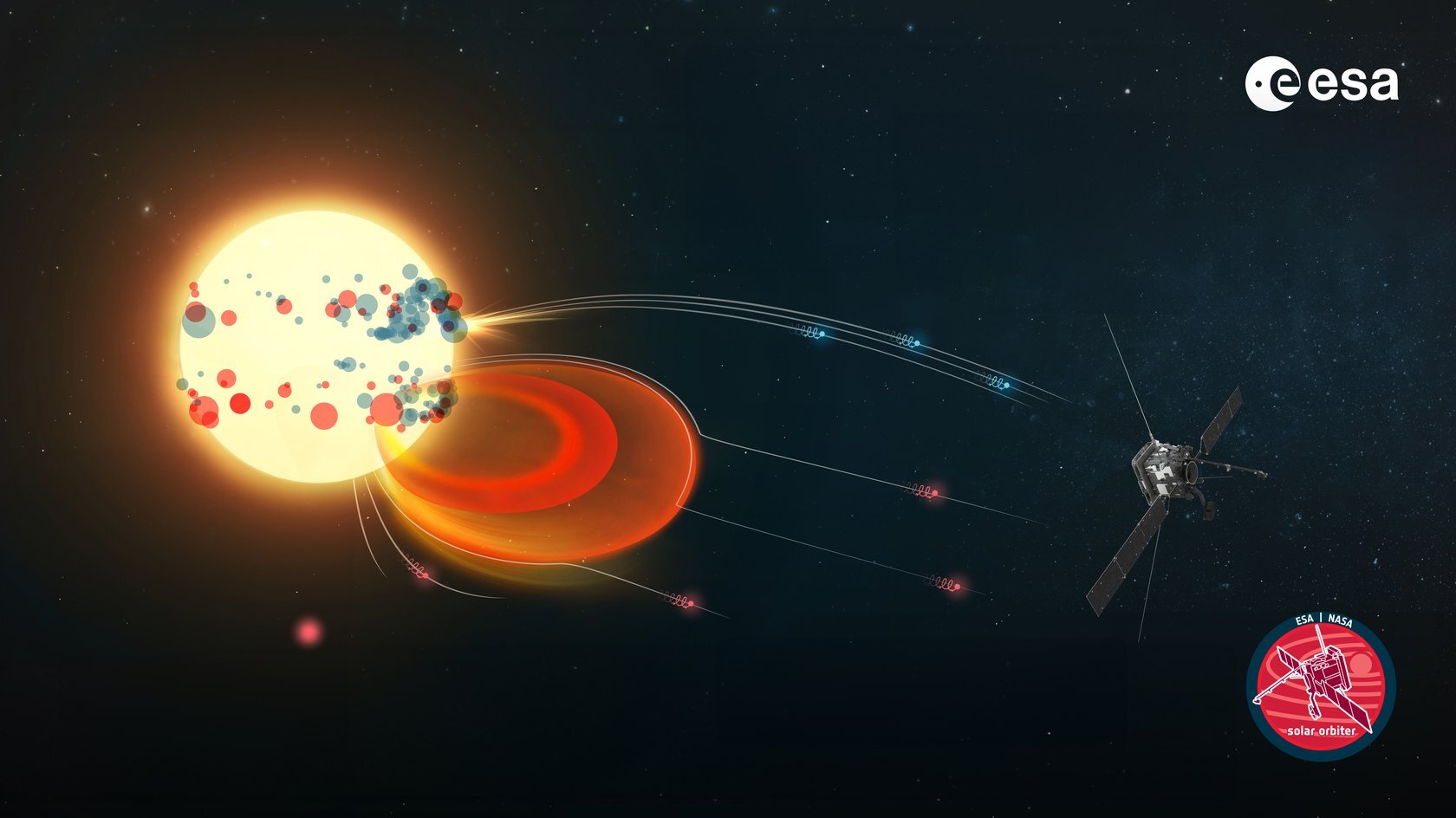19.02.2025

The European Space Agency (ESA) is ready to guide the ESA/NASA Solar Orbiter spacecraft through its closest encounter with Venus so far.
Today’s flyby will be the first to significantly ‘tilt’ the spacecraft’s orbit and allow it to see the Sun’s polar regions, which cannot be seen from Earth.
Studying the Sun’s poles will improve our understanding of solar activity, space weather, and the Sun-Earth connection.
Closer to Venus than ever before
Since launch in 2020, Solar Orbiter has carried out a number of gravity assists at Earth and Venus to gradually shrink its orbit and bring it closer to the Sun, but never before has it come as close to a planet as it will today, 18 February 2025.
At 21:48 CET, the spacecraft will pass within just 379 km of Venus. For comparison, astronauts aboard the International Space Station orbit Earth at an average altitude of 408 km.
“Getting so close to the planet allows us to use its gravity to significantly change the spacecraft’s orbit without using much fuel,” says ESA Flight Dynamics expert Julia Schwartz.
“The planets in our Solar System orbit the Sun in the same roughly flat plane. Today’s encounter with Venus will use the planet’s gravity to significantly ‘tilt’ Solar Orbiter’s orbit with respect to that plane. This will grant Solar Orbiter a much better view of the Sun’s polar regions, which cannot be seen from within the plane.”

Future Venus flybys, such as the one in December 2026, will further tilt the spacecraft’s orbit and enable high-resolution imaging of the Sun’s entire polar regions.
From its unique orbit, the mission will help us refine our understanding of solar activity and improve our ability to safeguard technology on Earth from powerful solar outbursts and erratic space weather.
Cool under pressure
Passing so close to Venus presents a number of challenges for the team at ESA’s European Space Operations Centre (ESOC) in Germany. Precise calculations and minor course corrections are necessary before and after the flyby to keep the spacecraft on track.
“The flyby has been carefully planned to get close enough to Venus to get the most out of the encounter while keeping the spacecraft safely above the planet’s atmosphere to avoid it experiencing drag,” says Sam Bammens from the Solar Orbiter Flight Control Team.
However, Solar Orbiter will still be bathed in the thermal radiation emitted by the planet as it passes.
“We expect Solar Orbiter to heat up significantly during the flyby. To prepare for this, the team carried out a detailed simulation of the heating effect of the Venus gravity assist manoeuvre. Several parts of the spacecraft will experience a significant temperature increase, but all components will stay well within their design limits.”
“For a few of us in the control team, it is our first flyby. During the planning, we learned a lot about what it takes to navigate the Solar System, and we are very excited for tonight.”
Cloudy with a chance for science
During the manoeuvre, Solar Orbiter will continue to point its ‘front’ – its instruments and, more importantly, its heat shield – towards the Sun to keep the spacecraft safe. That means it won’t be able to point any of its cameras towards Venus and its cloud tops during the flyby, but it is still an opportunity to gather some scientific data.
Unlike Earth, Venus lacks a global magnetic field to interact with the charged particles of the solar wind. However, a layer of its atmosphere known as the ionosphere interacts with the solar wind in unique ways.
Solar Orbiter’s Magnetometer and Radio and Plasma Waves sensors will be switched on as the spacecraft passes Venus to record the planet’s magnetic and plasma environment. The data they collect will contribute to ongoing research on how the solar wind affects planetary atmospheres beyond Earth.
ESA at Venus
Solar Orbiter is not the only ESA mission visiting Venus this year. ESA’s Juice spacecraft, en route to Jupiter to explore its icy moons, will also fly past the planet in August.
Solar Orbiter and Juice will pass Venus just 194 days apart – that’s less than one day on Venus, which lasts 243 Earth days. The frequent visits highlight the planet’s important role as a waypoint for ESA's interplanetary voyagers.
However, while Solar Orbiter and Juice are making just brief visits to Earth’s neighbour, for some ESA missions, Venus is the final destination. From arrival in 2006 until the end of the mission in 2014, ESA’s Venus Express studied the planet’s atmosphere and clouds in detail and mapped its surface temperature.
Looking ahead, ESA’s Envision is set to launch in the early 2030s. Envision will be the first mission to provide a comprehensive view of Venus from its inner core to its upper atmosphere. In doing so, it will help scientists determine how and why, despite starting off similar, Venus and Earth evolved in such different ways.

Access the video
Proba-3's first autonomous formation flight
Two spacecraft flying as one – that is the goal of European Space Agency’s Proba-3 mission. Earlier this week, the eclipse-maker moved a step closer to achieving that goal, as both spacecraft aligned with the Sun, maintaining their relative position for several hours without any control from the ground.

Computer screens line all sides of the control room at ESEC, ESA’s European Space Security and Education Centre in Redu, Belgium, displaying long lists of numbers, lines of code and complex graphs seemingly incomprehensible to an outside observer.
Monitoring the screens with undivided attention are engineers of Proba-3's flight control team, carefully analysing the data in front of them, ready to jump into problem-solving mode if any issues arise.

In precisely timed intervals, they send commands to the two Proba-3 satellites in space according to the flight plan – a series of steps scheduled for specific points in the spacecraft’s orbit.
Proba-3 is the world’s first precision formation flying mission. In their most precise configuration, its two spacecraft – the Coronagraph and the Occulter – will fly 150 metres apart in perfect formation, simulating a single giant spacecraft.
Once per orbit, the two spacecraft will align with the Sun so that the 1.4-m large disc carried by the Occulter casts a 5-cm shadow onto the optical instrument on the Coronagraph, allowing it to study the faint solar corona.

While several existing missions rely on formation flying technologies to operate, Proba-3’s two spacecraft will be the first to maintain their relative positions down to a few millimetres for hours at a time, without any control from the ground.
Earlier this week, the team in Redu executed the first stage of the complex flight operations needed to achieve the desired formation.
This first stage was dedicated to ground-commanded manoeuvres that brought the spacecraft closer to each other, from about 600 metres to only 144 metres apart. At the same time, the two were tasked with adopting their target alignment, in which the Coronagraph enters the shadow cast by the Occulter.

From here on, it was up to the spacecraft to autonomously adjust their position and maintain it for several hours.
Proba-3 mission manager Damien Galano describes how this crucial milestone was achieved: “First, we used GPS information to determine the precise location of the two satellites in space.
“Then we commanded the thrusters to eject small amounts of propellant to get the spacecraft as close as possible to the desired formation, to about 144 metres apart.
“Once the on-board autonomy was activated, the spacecraft measured and controlled their relative positioning using the Visual Based System, which consists of a wide-angle camera on the Occulter tracking a set of flashing LED lights on the Coronagraph, supplemented by a narrow-angle camera that enables a more precise positioning.”

“From here on, the spacecraft were maintaining their position autonomously, using the intersatellite link to exchange vital positioning information with each other,” notes Proba-3 systems engineer Teodor Bozhanov.
“Through the link, the Occulter spacecraft can also send instructions to its partner. If the positioning software detects a misalignment, the propulsion system can make small adjustments to get the two aligned again. At this stage, we were not interfering, only monitoring.
“For the Coronagraph spacecraft to move into the shadow cast by the Occulter, the system uses a set of shadow-detecting sensors that are located around the coronagraph instrument. This allows the satellites to stay in one line with the Sun.”

Proba-3 systems engineer Esther Bastida Pertegaz adds: “Over the past two days, we collected a wealth of data which we will now use to finetune the systems. In the coming weeks, we will do more testing to achieve the desired precision, making Proba-3 the world’s first-ever precision formation flying mission.
“The key words here are ‘precise’ and ‘autonomous’,” says Noelia Peinado of ESA’s General Support Technology Programme (GSTP), through which all of the positioning technology onboard Proba-3 was developed.
Many of the instruments that allow Proba-3 to autonomously perform precise formation flying are technology demonstrations – meaning this mission is devoted to proving their suitability for future space applications.
“It is the combination of all these instruments and software working together that make Proba-3 unique. A decade ago, none of these technologies were available – now we are about to accomplish what no one has before, enabling many more ambitious missions to come.”

Esther comments: “An endeavour like this brings together people from different areas of expertise. Systems engineers, flight dynamics engineers, spacecraft operators and subsystem experts all meet here in the control room to work together towards a common goal – to make ESA’s first autonomous precise formation flight happen. It’s a great privilege to be a part of it, witnessing two decades of efforts finally coming to fruition.”
Through In-Orbit Demonstration experiments, the General Support Technology Programme (GSTP) enables ESA to pioneer new technologies. Many of these demonstration missions have launched recently or are due to launch in the coming years, like the Agency’s first standalone deep space CubeSat HENON or the LUMIO CubeSat that will explore meteoroid impacts on the far side of the Moon.
Quelle: ESA
----
Solar Orbiter traces superfast electrons back to Sun

Credit: Credit: ESA & NASA/Solar Orbiter/STIX & EPD
The European Space Agency-led Solar Orbiter mission has split the flood of energetic particles flung out into space from the Sun into two groups, tracing each back to a different kind of outburst from our star. A newly published study led by scientists from the Leibniz Institute for Astrophysics Potsdam (AIP) presents a comprehensive catalogue of solar energetic electron events and shows that the apparent delay between solar eruptions and the detection of electrons in space is not due to late release, but to their turbulent journey through the solar wind.
The Sun is the most energetic particle accelerator in the Solar System. It whips up electrons to nearly the speed of light and flings them out into space, flooding the Solar System with so-called ‘Solar Energetic Electrons’ (SEEs). Researchers have now used Solar Orbiter to pinpoint the source of these energetic electrons and trace what we see out in space back to what’s actually happening on the Sun. They find two kinds of SEE with clearly distinct stories: one connected to intense solar flares (explosions from smaller patches of the Sun’s surface), and one to larger eruptions of hot gas from the Sun’s atmosphere (known as ‘coronal mass ejections’, or CMEs).
“We see a clear split between ‘impulsive’ particle events, where these energetic electrons speed off the Sun’s surface in bursts via solar flares, and ‘gradual’ ones associated with more extended CMEs, which release a swell of particles over longer periods of time and over broader angular ranges,” says lead author Alexander Warmuth of the Leibniz Institute for Astrophysics Potsdam (AIP), Germany.
While scientists were aware that two types of SEE events existed, Solar Orbiter was able to comprehensively measure a large number of events, and look far closer to the Sun than other missions had, to reveal how they form and leave the surface of our star.
“We were only able to identify and understand these two groups by observing hundreds of events at different distances from the Sun with multiple instruments – something that only Solar Orbiter can do,” adds Alexander. By going so close to our star, we were able to measure the particles in a pristine state and could thus accurately determine the time and place where they started at the Sun.
The study is the most comprehensive of SEE events to date, and produces a catalogue that will only grow through Solar Orbiter’s lifetime. It used eight of Solar Orbiter’s ten instruments to observe more than 300 events between November 2020 and December 2022. This research showcases the power of collaboration – it was only possible due to the combined expertise and teamwork of European scientists, instrument teams from across ESA Member States, and colleagues from the US, coordinated by scientists from AIP.
“It’s the first time we’ve clearly seen this connection between particles in space and their source events taking place at the Sun,” adds co-author Frederic Schuller, also of AIP. “We measured the energetic electrons in situ – that is, Solar Orbiter actually flew through the electron streams – while simultaneously using more of the spacecraft’s instruments to observe what was happening at the Sun. We also gathered information about the space environment between the Sun and spacecraft.”
The researchers detected SEE events at different distances from the Sun. This let them study how the electrons behave as they travel through the Solar System, answering a lingering question about these energetic particles.
When we spot a flare or CME, there’s often an apparent lag between what we see taking place at the Sun, and the release of SEEs into space. In extreme cases, the particles seem to take hours to escape. Why?
“It turns out that this is related to how the electrons travel through space – it’s not a lag in release, but a lag in detection,” says co-author and ESA Research Fellow Laura Rodríguez-García. “The electrons encounter turbulence, get scattered in different directions, and so on, so we don’t spot them immediately. These effects build up as you move further from the Sun.”
The space between the Sun and the planets of the Solar System isn’t empty. A wind of charged particles streams out from the Sun constantly, dragging the Sun’s magnetic field with it. It fills space and influences how the particles travel; rather than being able to go where they like, the SEEs are confined, scattered, and disturbed by this wind and its magnetism.
The study fulfils an important goal of Solar Orbiter: to continuously monitor our star and its surroundings to trace ejected particles back to their sources at the Sun.
“Thanks to Solar Orbiter, we’re getting to know our star better than ever,” says Daniel Müller, ESA Project Scientist for Solar Orbiter. “During its first five years in space, Solar Orbiter has observed a wealth of solar energetic particle events. As a result, we’ve been able to perform detailed analyses and assemble a unique database for the worldwide community to explore.”
Crucially, the finding is important for our understanding of space weather, where accurate forecasting is essential to keep our spacecraft operational and safe. One of the two kinds of SEE is more important for space weather: that connected to CMEs, which tend to hold more high-energy particles and so threaten far more damage. Because of this, being able to distinguish between the two types of SEE is hugely relevant for our forecasting.
Solar Orbiter is a space mission of international collaboration between ESA and NASA, operated by ESA.

